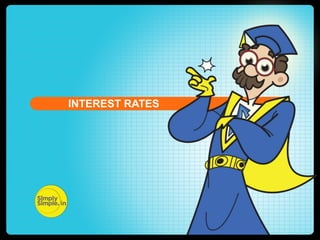
How Interest Rates Work
- 2. INTEREST RATES You're watching the news and they're talking about a recent announcement from RBI, in which it is hinted that the interest rates may be raised in the next week. The stock market drops the next day. Why?
- 3. INTEREST RATES How Do Interest Rates Work Before you get all worked up, you should know that interest rates aren't evil. They're the price of living in a world that relies heavily on credit and debt. If interest rates didn't exist, lenders would have no reason to let you borrow money.
- 4. INTEREST RATES And if you couldn't borrow money, you could never buy a house or a car, or enjoy many of the other advantages of life with credit, like buying air tickets and paying bills online with a credit card.
- 5. INTEREST RATES So if interest rates are so important, how do they work? In this lesson, I'll help you understand why interest rates exist, how they're calculated and why they change over time
- 6. INTEREST RATES An interest rate is the cost of borrowing money. A borrower pays interest for the ability to spend money now, rather than wait until he's saved the same amount.
- 7. INTEREST RATES For example, if you borrow R100 at an annual interest rate of five percent, at the end of the year you'll owe 105. But interest rates aren't just random punishments for borrowing money. The interest a lender receives is his compensation for taking a risk. How?
- 8. INTEREST RATES With every loan, there's a risk that the borrower won't be able to pay it back. The higher the risk that the borrower will default (or fail to repay the loan), the higher the interest rate. That's why maintaining a good credit score will help lower the interest rates offered to you by lenders
- 9. INTEREST RATES The nice thing is that interest rates work both ways. Banks, governments and other large financial institutions need cash too, and they're willing to pay for it. If you put money into a savings account at a bank, the bank will pay you interest for the temporary use of that money
- 10. INTEREST RATES Governments sell bonds and other securities for the same reason. In this case, you're the lender to the government and the interest rate is your compensation for temporarily giving up the ability to spend your cash. But remember, savings accounts and governmentissued bonds pay relatively low interest rates because the risk of their defaulting is close to zero.
- 11. INTEREST RATES You should also know that interest rates for unsecured credit will always be higher than secured credit. Secured credit is backed by collateral. A home loan is a classic example of secured credit, because if the borrower defaults on the loan, the bank can always take the house. Credit cards are unsecured credit, because there's no collateral backing the loan, only the cardholder's credit score.
- 12. INTEREST RATES Long-term loans also carry higher interest rates than short-term loans, because the more time a borrower has to pay back a loan, the more time there is for things to possibly go bad financially, causing the borrower to default
- 13. INTEREST RATES Another factor that makes long-term loans less attractive to lenders -- and therefore raises long-term interest rates -- is inflation. In a healthy economy, inflation almost always rises, meaning the same rupee amount today is worth less five years from now. Lenders know that the longer it takes the borrower to pay back a loan, the less that money is going to be worth.
- 14. INTEREST RATES That's why interest rates are actually calculated as two different values: the nominal rate and the real rate. The nominal rate is the interest rate set by the lending institution. The real rate is the nominal rate minus the rate of inflation.
- 15. INTEREST RATES For example, if you take out a home loan with a nominal interest rate of 10 percent, but the annual rate of inflation is four percent, then the bank is only really collecting six percent on the loan
- 16. INTEREST RATES So how do interest rates affect the rise and fall of inflation? Well, lower interest rates put more borrowing power in the hands of consumers. And when consumers spend more, the economy grows, naturally creating inflation.
- 17. INTEREST RATES If the RBI decides that the economy is growing too fast-that demand will greatly outpace supply-then it can raise interest rates, slowing the amount of cash entering the economy. So there must be enough economic growth to keep wages up and unemployment low, but not too much growth that it leads to dangerously high inflation.
- 18. CURRENT ACCOUNT DEFICIT INTEREST RATES Let us see the formula of the Current Account Balance (CAB) CAB = X - M + NI + NCT X = Exports of goods and services M = Imports of goods and services NI = Net income abroad [Salaries paid or received, credit / debit of income from FII & FDI etc. ] NCT = Net current transfers [Workers' Remittances (unilateral), Donations, Aids & Grants, Hope you have understood the Official, Assistance and concept of Interest Rates. Pensions etc]
- 19. Please give us your feedback at professor@tataamc.com
- 20. DISCLAIMER The lesson is a conceptual representation and may not include several nuances that are associated and vital. The purpose of this lesson is to clarify the basics of the concept so that readers at large can relate and thereby take more interest in the product / concept. In a nutshell, Professor Simply Simple lessons should be seen from the perspective of it being a primer on financial concepts. Mutual Fund investments are subject to market risks, read all scheme related documents carefully.